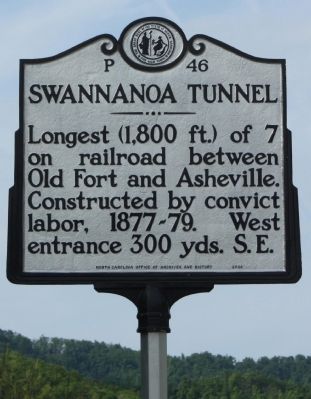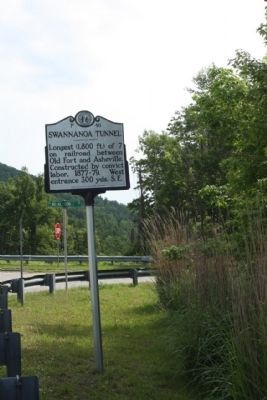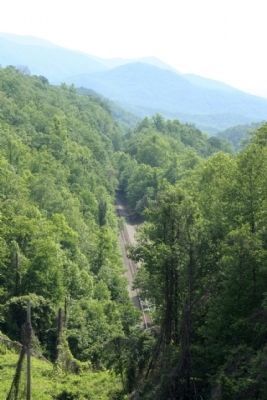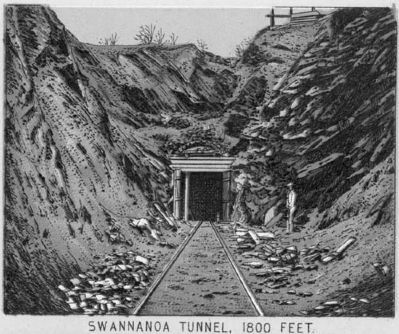Ridgecrest in Buncombe County, North Carolina — The American South (South Atlantic)
Swannanoa Tunnel
Erected 2008 by North Carolina Office of Archives and History. (Marker Number P-46.)
Topics and series. This historical marker is listed in this topic list: Railroads & Streetcars. In addition, it is included in the North Carolina Division of Archives and History series list.
Location. 35° 37.309′ N, 82° 16.32′ W. Marker is in Ridgecrest, North Carolina, in Buncombe County. Marker is at the intersection of Yates Avenue and Royal Gorge Road, on the right when traveling north on Yates Avenue. Located where Old US 70 changes to Royal Gorge Road, at Yates Avenue. Touch for map. Marker is in this post office area: Black Mountain NC 28711, United States of America. Touch for directions.
Other nearby markers. At least 8 other markers are within 3 miles of this marker, measured as the crow flies. Swannanoa Gap Engagement (within shouting distance of this marker); Swannanoa Gap (about 700 feet away, measured in a direct line); Stoneman's Raid (approx. 0.4 miles away); Mount Mitchell Railroad (approx. 1.6 miles away); Boone Trail Highway (approx. 2.3 miles away); Montreat's Rich Heritage is a Place of Renewal (approx. 2.3 miles away); Lake Susan (approx. 2.3 miles away); Beetles Bring Hope for Hemlock Survival (approx. 2.3 miles away). Touch for a list and map of all markers in Ridgecrest.
Regarding Swannanoa Tunnel. Western North Carolina Railroad’s Swannanoa Tunnel opened on March 11, 1879. At a length of 1,800 feet, it was the longest of the seven tunnels on the railroad between Old Fort and Asheville. The milestone in the development of western North Carolina opened the region and released it from its state of isolation. Before the construction of the railroad, the Buncombe Turnpike was Western North Carolina’s primary connection to the outside world. When the drought of 1845 resulted in total crop failure for mountain farms, pack trains and loaded wagons were unable to provide the frontier families with enough food to carry them through to the next crop. As a consequence, political leaders in the mountains demanded that the state provide a railroad link to Asheville. Ten years later the General Assembly finally passed legislation for the construction of a western North Carolina railroad connection.
By the beginning of the Civil War, all but seventy miles of the route into Asheville was complete. During
Reconstruction, the state secured four million dollars in state bonds for the completion of the railroad. However, George W. Swepson, in his capacity as president of the western division of the Western North Carolina Railroad (WNCRR), and Milton S. Littlefield embezzled the bonds, further delaying the railroad’s completion. Construction of the railroad did not resume until 1877 when the WNCRR was organized with the state holding three-fourths of their stock. The General Assembly authorized the use of 500 convicts to provide the labor for the project.
James W. Wilson, who became president, superintendent, and chief engineer of the WNCRR, oversaw its completion. The hazardous construction involved drilling holes in the mountains of solid rock, blasting the rock, and removing the rubble. Wilson hired an engineer who introduced nitroglycerine as an explosive to replace black powder. The explosive paste that the engineer created using nitroglycerine, sawdust, and corn meal dislodged larger rocks. One hundred and twenty-five men lost their lives during the construction of the Swannanoa Tunnel. The tunnel was holed through on March 11, 1879. By October of 1880, the tracks were clear and the first train from Salisbury entered Asheville. Asheville was not the end of the line for the WNCRR, but rather it pushed farther down the French Broad River to Paint
Rock and ended in Murphy in 1891. ( North Carolina Dept. of Cultural Resources)
Credits. This page was last revised on June 22, 2021. It was originally submitted on June 28, 2012, by Mike Stroud of Bluffton, South Carolina. This page has been viewed 2,396 times since then and 158 times this year. Photos: 1, 2, 3. submitted on June 28, 2012, by Mike Stroud of Bluffton, South Carolina. 4. submitted on June 29, 2012, by Mike Stroud of Bluffton, South Carolina. 5. submitted on June 28, 2012, by Mike Stroud of Bluffton, South Carolina.




